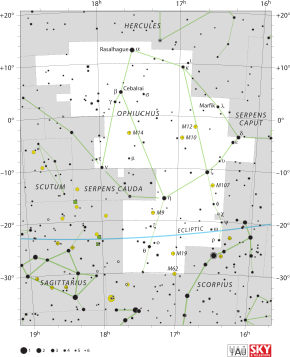This is an old revision of this page, as edited by 24.17.170.181 (talk) at 06:26, 14 January 2011 (→Astrology). The present address (URL) is a permanent link to this revision, which may differ significantly from the current revision.
Revision as of 06:26, 14 January 2011 by 24.17.170.181 (talk) (→Astrology)(diff) ← Previous revision | Latest revision (diff) | Newer revision → (diff) This article is about the constellation. For the astrological sign, see Ophiuchus (astrology). For the roots rock music group, see Ophiuchus (band). For the manga character, see Ophiuchus Shaina.| Constellation | |
 List of stars in Ophiuchus List of stars in Ophiuchus | |
| Abbreviation | Oph |
|---|---|
| Genitive | Ophiuchi |
| Pronunciation | Template:IPA-en Óphiúchus, genitive /ˌɒfiːˈjuːkaɪ/ |
| Symbolism | The snake-holder, the healer |
| Right ascension | 17 |
| Declination | −8 |
| Quadrant | SQ3 |
| Area | 948 sq. deg. (11th) |
| Main stars | 10 |
| Bayer/Flamsteed stars | 62 |
| Stars with planets | 7 |
| Stars brighter than 3.00 | 5 |
| Stars within 10.00 pc (32.62 ly) | 11 |
| Brightest star | α Oph (Ras Alhague) (2.08) |
| Messier objects | 7 |
| Meteor showers | Ophiuchids Northern May Ophiuchids Southern May Ophiuchids Theta Ophiuchids |
| Bordering constellations | Hercules Serpens Libra Scorpius Sagittarius Aquila |
| Visible at latitudes between +80° and −80°. Best visible at 21:00 (9 p.m.) during the month of July. | |
Ophiuchus is a large constellation located around the celestial equator. Its name is Greek (Ὀφιοῦχος) for 'serpent-bearer', and it is commonly represented as a man grasping the snake that is represented by the constellation Serpens. Ophiuchus was one of the 48 constellations listed by the second-century astronomer Ptolemy, and it remains one of the 88 modern constellations. It was formerly referred to as Serpentarius Template:IPA-en, a Latin word meaning the same as its current name.
Location
It is located between Aquila, Serpens and Hercules, northwest of the center of the Milky Way. The southern part lies between Scorpius to the west and Sagittarius to the east. It is best visible in the northern summer and located opposite Orion in the sky. Ophiuchus is depicted as a man grasping a serpent; the interposition of his body divides the snake constellation Serpens into two parts, Serpens Caput and Serpens Cauda, which are nonetheless counted as one constellation.
Notable features

Stars

The brightest stars in Ophiuchus include α Ophiuchi, called Rasalhague (at the figure's head), and η Ophiuchi.
RS Ophiuchi is part of a class called recurrent novae, whose brightness increase at irregular intervals by hundreds of times in a period of just a few days. It is thought to be at the brink of becoming a type-1a supernova.
Barnard's Star, one of the nearest stars to the Solar System (the only stars closer are the Alpha Centauri binary star system and Proxima Centauri), lies in Ophiuchus. (It is located to the left of β and just north of the V-shaped group of stars in an area that was once occupied by the now-obsolete constellation of Taurus Poniatovii, Poniatowski's Bull.)
In 2005, astronomers using data from the Green Bank Telescope discovered a superbubble so large that it extends beyond the plane of the galaxy. It is called the Ophiuchus Superbubble.
In April 2007, astronomers announced that the Swedish-built Odin satellite had made the first detection of clouds of molecular oxygen in space, following observations in the constellation Ophiuchus.
The supernova of 1604 was first observed on October 9, 1604, near θ Ophiuchi. Johannes Kepler saw it first on October 16 and studied it so extensively that the supernova was subsequently called Kepler's Supernova. He published his findings in a book titled De stella nova in pede Serpentarii (On the New Star in Ophiuchus' Foot). Galileo used its brief appearance to counter the Aristotelian dogma that the heavens are changeless.
In approximately 40,000 years Voyager 1 probe will pass within 1.6 light years of the star AC+79 3888, which is located in Ophiuchus.
In 2009 it was announced that GJ 1214, a star in Ophiuchus, undergoes repeated, cyclical dimming with a period of about 1.5 days consistent with the transit of a small orbiting planet. Further, the authors conclude that the planet must have a low density consistent with vast quantities of water. The proximity of this star to Earth (42 light years) makes it a tempting target for further astronomic observations.
In April 2010, the naked-eye star ζ Ophiuchi was occulted by 824 Anastasia.
Deep-sky objects
Ophiuchus contains several star clusters, such as IC 4665, NGC 6633, M9, M10, M12, M14, M19, M62, and M107, as well as the nebula IC 4603-4604. The unusual galaxy merger remnant NGC 6240 is also in Ophiuchus. In 2006, a new nearby star cluster was discovered associated with the 4th magnitude star Mu Ophiuchi. The Mamajek 2 cluster appears to be a poor cluster remnant analogous to the Ursa Major Moving Group, but 7 times more distant (approximately 170 parsecs away). Mamajek 2 appears to have formed in the same star-forming complex as the NGC 2516 cluster roughly 135 million years ago.
Mythology
| This section possibly contains original research. Please improve it by verifying the claims made and adding inline citations. Statements consisting only of original research should be removed. (December 2008) (Learn how and when to remove this message) |

There exist a number of theories as to whom the figure represents.
The most recent interpretation is that the figure represents the healer Asclepius, who learned the secrets of keeping death at bay after observing one serpent bringing another healing herbs. To prevent the entire human race from becoming immortal under Asclepius' care, Zeus killed him with a bolt of lightning, but later placed his image in the heavens to honor his good works. It has also been noted that the constellation Ophiuchus is close to that of Sagittarius, which has at times been believed to represent Chiron (the mentor of Asclepius and many other Greek demigods), though Chiron was originally associated with the constellation Centaurus.
Another possibility is that the figure represents the Trojan priest Laocoön, who was killed by a pair of sea serpents sent by the gods after he warned the Trojans not to accept the Trojan Horse. This event was also memorialized by the sculptors Agesander, Athenodoros, and Polydorus in the famous marble sculpture Laocoön and his Sons, which stands in the Vatican Museums.
A third possibility is Apollo wrestling with the Python to take control of the oracle at Delphi.
A fourth is the story of Phorbas, a Thessalonian who rescued the people of the island of Rhodes from a plague of serpents and was granted a place in the sky in honor of this deed.
According to Gavin White, Ophiuchus may represent the Babylonian constellation known as the Sitting Gods (Mul.Dingir.Tush.A.Mesh), which he proposes was originally a human figure whose legs have been replaced by the tail of a huge serpent.
Astrology
Main article: Ophiuchus (astrology)Until recently, Ophiuchus was not included in standard astrological zodiacs, which divide the ecliptic into abstract 30-degree segments (implying exactly 12 signs), rather than using the physical constellations. Only a few astrologers, those using a sidereal zodiac, use it as the 13th zodiacal sign.
January 2011, Ophiuchus was officially recognized as the 13th sign, falling between Scorpio and Sagittarius, beginning November 29 and ending December 17.
Symbol


Two symbols have been proposed for Ophiuchus, one based on the Rod of Asclepius (Unicode ⚕, U+2695) and the other in general use in Japanese astrology (Unicode ⛎, U+26CE).
Since Ophiuchus is identified with Asclepius, the Rod of Asclepius is often used as a symbol for Ophiuchus. In Japan, an astrological symbol for Ophiuchus is in widespread use. The symbol is sufficiently common to be included in emoji.
Citations
- Star 'soon to become supernova'. BBC News, 2006-07-23
- "Huge 'Superbubble' of Gas Blowing Out of Milky Way". PhysOrg.com. 2006-01-13. Retrieved 2008-07-04.
- Molecular Oxygen Detected For The First Time In The Interstellar Medium
- Voyager - Mission - Interstellar Mission
- Charbonneau et al. "A super-Earth transiting a nearby low-mass star" Nature 462, 891-894 (17 December 2009)
- Mamajek, Eric E. (2006). "A New Nearby Candidate Star Cluster in Ophiuchus at d = 170 pc". Astronomical Journal. 132: 2198. doi:10.1086/508205.
{{cite journal}}: line feed character in|journal=at position 13 (help) - Jilinski, E., Ortega, V.G., de la Reza, R., Drake, N.A., and Bazzanella, B. (2009). "Dynamical Evolution and Spectral Characteristics of the Stellar Group Mamajek 2". Astrophysical Journal. 691: 212. doi:10.1088/0004-637X/691/1/212.
{{cite journal}}: CS1 maint: multiple names: authors list (link) - Babylonian Star-lore by Gavin White, Solaria Pubs, 2008, page 191
References
- Ian Ridpath and Wil Tirion (2007). Stars and Planets Guide, Collins, London. ISBN 978-0007251209. Princeton University Press, Princeton. ISBN 978-0691135564.
External links
![]() Media related to Ophiuchus at Wikimedia Commons
Media related to Ophiuchus at Wikimedia Commons
| The 88 modern constellations | |
|---|---|
| |
| Constellation history | |||||||||
|---|---|---|---|---|---|---|---|---|---|
| |||||||||
| |||||||||
|